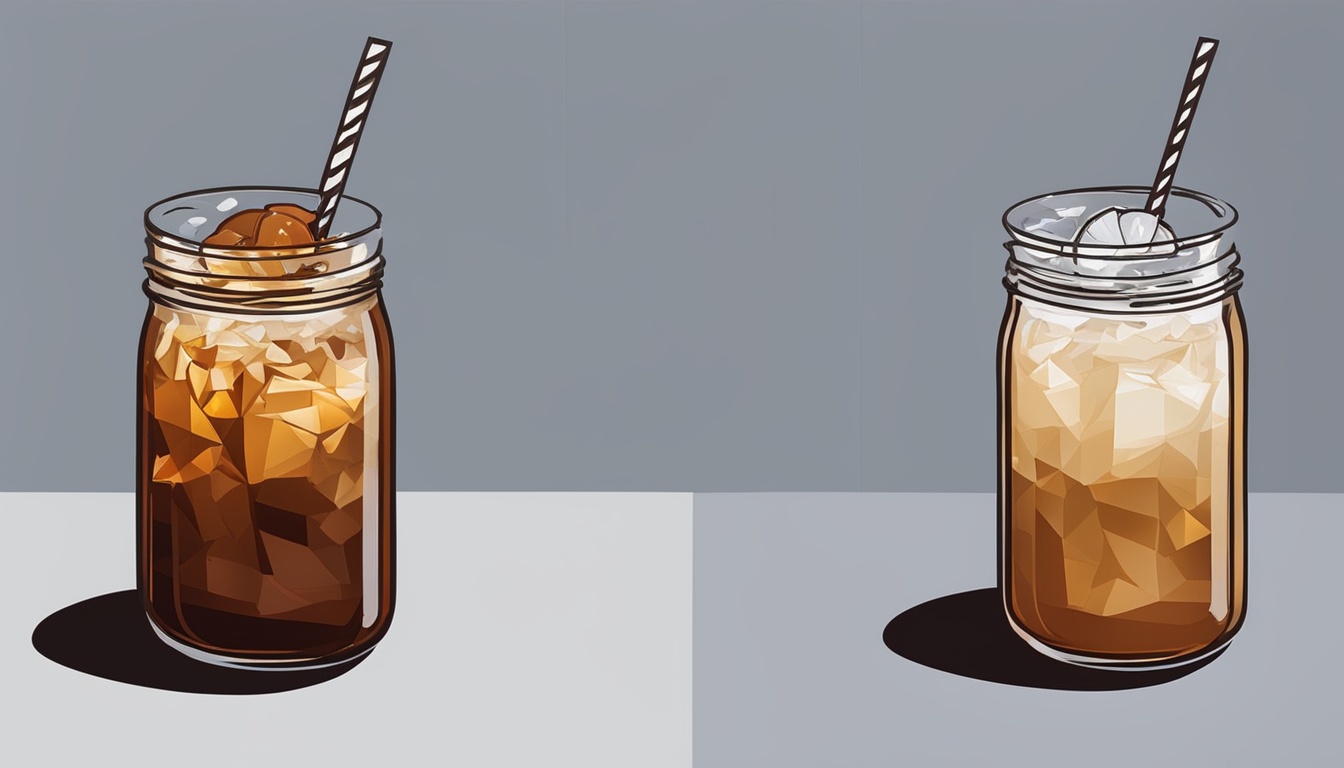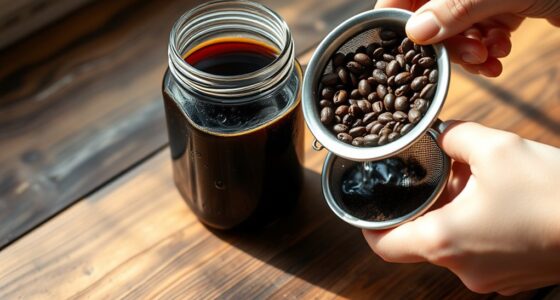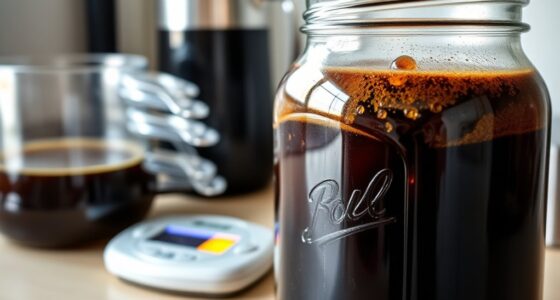Did you realize that a 16 oz. cold brew contains more than 200 mg of caffeine? The iced version has approximately 165 mg. This difference in caffeine content sparks the discussion on which option is better for you. The cold brew market is projected to increase by $1.37 billion in North America between 2020 and 2025. Coffee enthusiasts are interested in the brewing techniques, flavor, and health benefits of each. We delve into these aspects to assist you in choosing the option that suits your health and taste preferences.
Key Takeaways
- Cold brew coffee offers more caffeine than iced coffee.
- The cold brew market is expanding rapidly in North America.
- Cold brew can be stored longer than iced coffee.
- Cold brew is typically lower in calories and sugar.
- Both drinks have unique health benefits linked to coffee consumption.
Understanding Cold Brew Coffee
Cold brew coffee is very popular, especially among those who like a smooth drink. It’s different from regular coffee because it’s less acidic. To make it, you steep coarse coffee grounds in cold water for 12-24 hours. This creates a rich flavor with hints of chocolate or nuts.
What is Cold Brew?
Cold brew is a unique way to make coffee. It doesn’t use heat, which means the coffee is less acidic and bitter. This slow brewing process brings out full flavors. You can enjoy the concentrate as is or mix it with water or milk.
Brewing Method for Cold Brew
The key to cold brew is steeping coarsely ground coffee carefully. A 1:4 ratio of coffee to water works well. This ratio helps get the perfect flavor strength. After brewing, you can keep the coffee in the fridge for two weeks. It’s a great way to have delicious coffee ready anytime.

Cold brew coffee is smooth, not too acidic, and very popular. It’s found in many cafes and homes. By understanding how it’s made, people can really enjoy its unique taste. Cold brew is great for different occasions.
Exploring Iced Coffee
Iced coffee is a favorite for many. It’s made by first brewing coffee hot and then cooling it over ice. This method keeps the coffee’s acidity and flavors, making it a refreshing drink.
What is Iced Coffee?
Iced coffee is both traditional and refreshing. It’s for those who like their coffee cold but rich. It’s made with the classic brewing method, not like cold brew. So, it tastes like regular coffee but is served cold, perfect for hot days.
Brewing Method for Iced Coffee
Starting with freshly brewed coffee is key to making iced coffee. Here are the steps:
- Begin by brewing a rich batch of coffee using your preferred method.
- Let the brewed coffee cool to room temperature.
- Pour the cooled coffee into a glass full of ice.
- Add milk or sweetener as you like.
The cool down ensures the taste and acidity stay intact. Iced coffee offers a balanced taste. If you prefer less caffeine, have it without extra calories. Yet, many enjoy it with milk or sweeteners for added flavor.
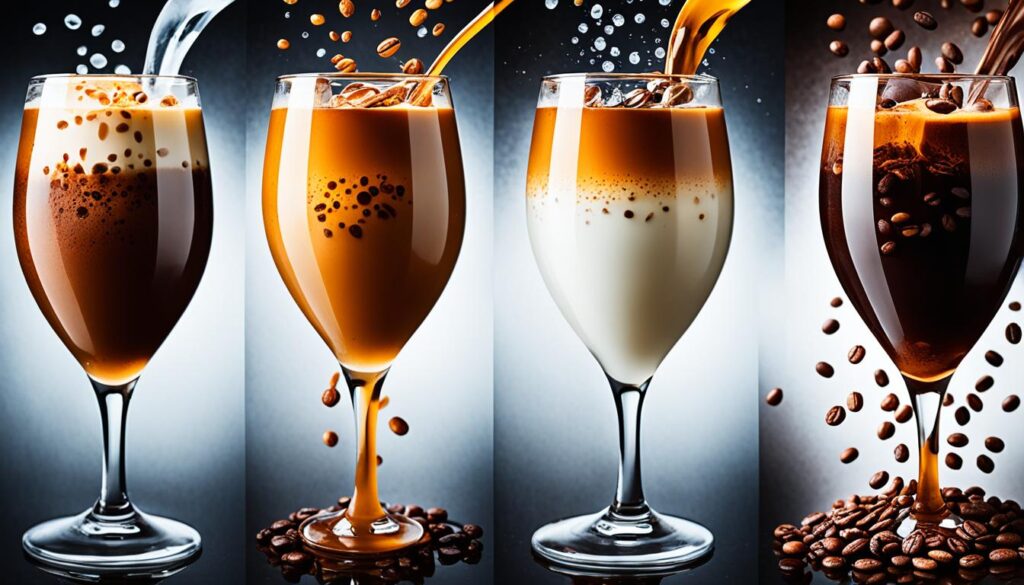
Key Differences Between Cold Brew and Iced Coffee
Want to find your perfect cup? Know the key differences between cold brew and iced coffee. Each has unique brewing techniques that affect their taste and caffeine content. Let’s dive into what sets these popular drinks apart.
Brewing Time and Technique
Cold brew takes time, allowing coffee to steep in room temperature water for 12 to 24 hours. This slow extraction results in a strong concentrate. It’s known for its smooth flavor. Iced coffee is different. It’s hot coffee cooled down quickly and usually served over ice. Its quick brewing leads to a more acidic, sometimes bitter taste.
Flavor Profiles
Cold brew is known for being mellow and sweet, without the bitterness common in hot-brewed coffee. Its unique brewing method gives it a distinct, smooth taste. Iced coffee has a bolder taste with sharper acidity. This is because its hot brewing process pulls out more from the coffee. It offers a stronger taste that many coffee lovers enjoy.
Caffeine Content
Caffeine is another big difference. Cold brew often has about 200 mg of caffeine per 16 oz. It’s stronger than iced coffee, which has about 165 mg of caffeine. The lengthy steeping of cold brew pulls out more caffeine. This makes it a great choice for those needing an energy boost without losing flavor.

| Aspect | Cold Brew | Iced Coffee |
|---|---|---|
| Brewing Time | 12 to 24 hours | Minutes |
| Flavor Profile | Smooth, less acidic | Bolder, more acidic |
| Caffeine Content | ~200 mg per 16 oz. | ~165 mg per 16 oz. |
Cold Brew vs. Iced Coffee: Which is better for your health?
Cold brew and iced coffee are popular drinks with different health benefits. Cold brew is especially appealing because of its acidity levels. It’s 65% less acidic than iced coffee, which is easier on your stomach. Additionally, cold brew has a smoother, less bitter taste compared to iced coffee. This can make it more enjoyable for those who are sensitive to strong flavors. Furthermore, cold brew coffee tends to have a higher caffeine content, which can provide an extra energy boost. When considering the pourover coffee vs drip comparison, cold brew stands out for its unique brewing method and distinct flavor profile.
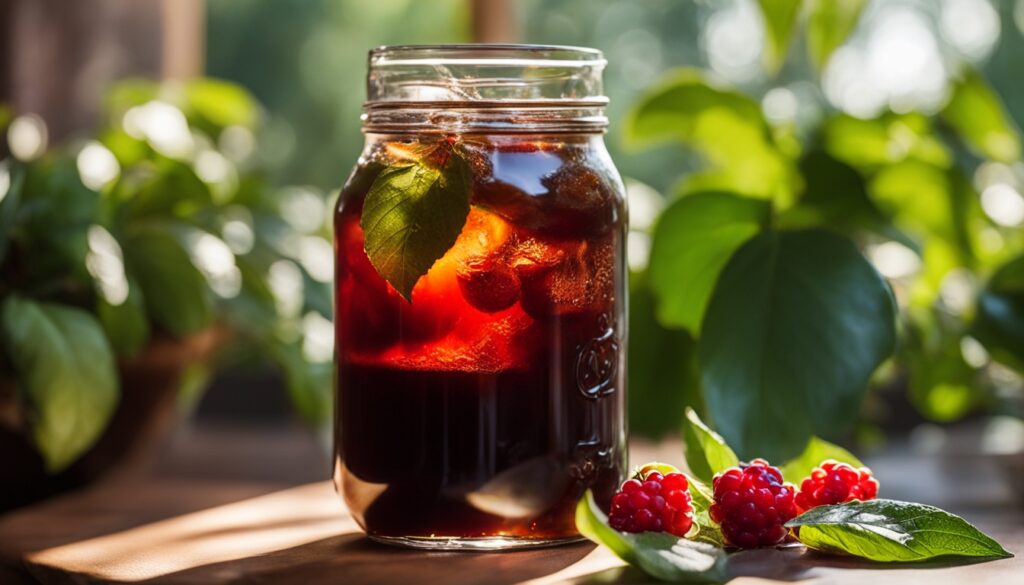
Cold brew has more antioxidants. This is because of how it’s made. It’s soaked in cold water for over twelve hours. This method pulls out good compounds without making the coffee bitter. On the other hand, iced coffee might taste watered down since it’s just hot coffee cooled off and poured over ice.
Cold brew is naturally sweeter, needing less sugar. This makes it a healthier option. It fits well in a diet that watches sugar intake. By using less sweetener, you’re choosing a healthier drink.
In summary, cold brew stands out for its health benefits. It offers lower acidity, more antioxidants, and doesn’t need much sugar. It can even save money when made at home. Each coffee type has its perks, but cold brew might be the better choice for your health.
Health Benefits of Cold Brew Coffee
Cold brew coffee is loved for its health benefits. It’s a favorite among coffee lovers. The way it’s made not only makes it tasty but also healthy. For example, it’s easier on the stomach due to its low acidity.
This low acidity helps people with sensitive stomachs. We’ll dive deeper into these benefits in this article.
Lower Acidity Levels
Cold brew coffee is less acidic than regular coffee. This is good news for people with sensitive stomachs or those who experience acid reflux. Less acidity means it’s softer on your digestive system. So, more folks can enjoy coffee without the usual discomfort.
Higher Antioxidant Content
Cold brew is rich in antioxidants. These antioxidants are crucial in fighting off oxidative stress. They help reduce inflammation and protect cells, which is great for your health. Adding cold brew to your daily habits can help guard against chronic diseases.
Friendlier for Sensitive Stomachs
Cold brew’s smooth taste is better for people with sensitive stomachs. This smoothness means they don’t have to add sugar or cream to enjoy it. This makes it a healthier choice. Cold brew offers a pleasant drink while keeping the health perks.

| Health Benefit | Impact | Advantages of Cold Brew |
|---|---|---|
| Lower Acidity | Less irritation for sensitive stomachs | Better digestive comfort |
| Antioxidant Content | Combats inflammation and oxidative stress | Supports overall health |
| Smoother Taste Profile | More palatable for many | Reduces need for added sugars |
Health Benefits of Iced Coffee
Iced coffee is not just tasty; it also boosts health in many ways. It can improve your brain’s performance and speed up your metabolism. Knowing these benefits helps people choose their drinks wisely.
Potential Cognitive Boost
Iced coffee is packed with caffeine benefits that help wake up your brain. It can make you more alert and enhance your memory. This could lead to a more effective day.
Increased Metabolism
Drinking iced coffee might help you burn more calories. This is because it can boost your metabolism for a short time. It’s a great choice for those wanting to stay fit and enjoy a cool beverage.
Common Antioxidants
Iced coffee is full of antioxidants that fight off damage in your body. Even though hot coffee has more antioxidants, iced coffee still has plenty. Drinking it regularly might help prevent heart problems and stroke thanks to these healthful substances.

| Health Benefit | Details |
|---|---|
| Cognitive Function | Enhances alertness and memory through caffeine. |
| Metabolism Support | Temporarily increases metabolic rate aiding in weight management. |
| Antioxidants | Contains antioxidants, contributing to reduced oxidative stress. |
| Heart Health | Moderate consumption linked to lower risks of heart disease. |
Adding iced coffee to your daily diet can be beneficial if done carefully. However, it’s also good to know about possible negatives like anxiety or sleep issues. This way, you can enjoy its perks without the downsides.
Flavor Comparisons: Cold Brew vs. Iced Coffee
The taste of cold brew and iced coffee is quite different. This difference matters to coffee lovers. Knowing the taste of each can help people choose what they like best.
Cold Brew Flavor Profile
Cold brew has a smooth taste that many enjoy. It’s less acidic than regular coffee, which means it’s not as bitter. This makes it pleasant to drink.
To make cold brew, coffee grounds soak in cold water for at least 12 hours. This long process pulls out sweet flavors. People often say it tastes like chocolate or nuts.
Iced Coffee Flavor Profile
Iced coffee, meanwhile, has a bold and refreshing taste. It’s made hot then poured over ice. This method keeps the coffee’s strong flavors.
Some prefer iced coffee for its quick boost and sharp taste. But it might not be as smooth as cold brew. This makes each cup unique to its drinker.

Which Coffee Contains More Caffeine?
When we look at caffeine content, cold brew coffee comes out on top. This is mainly because of how it’s made. A typical 16-ounce serving has about 200 mg of caffeine. Some well-known brands, like Starbucks, have around 205 mg in the same serving. Dunkin’ Donuts even offers 260 mg per 16 ounces.
Iced coffee usually has less caffeine. For instance, a 16-ounce serving contains about 165 mg. This makes a big difference for those who want a strong caffeine kick. Cold brew’s method extracts more caffeine, thanks to its long steeping time.
The caffeine in cold brew can vary. It depends on the coffee beans, how fine they’re ground, and how long they brew. Cold brew uses a coffee-to-water ratio of 1:4 to 1:9. This makes it stronger and more concentrated. Iced coffee, however, doesn’t use such a method, resulting in less caffeine.
Hot coffee has the highest caffeine content, with 210-360 mg per 16 ounces. But cold brew is still more caffeinated than iced coffee and espresso. Knowing these caffeine levels helps consumers make better choices about their caffeine intake.
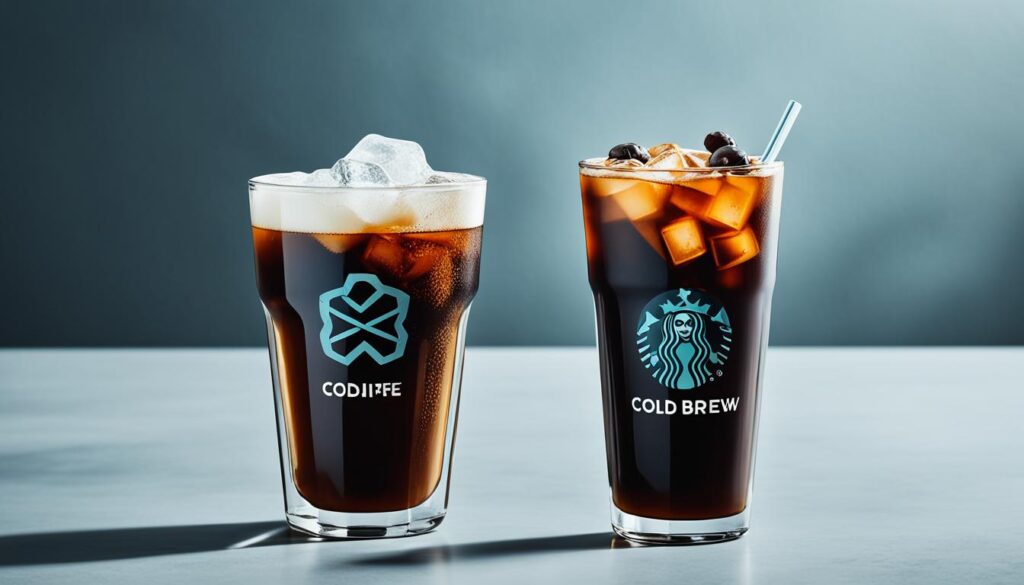
Home Brewing Techniques
Home brewing excites those who love coffee and enjoy playing with tastes. Cold brew and iced coffee are two favorite methods that anyone can learn. They make your coffee experience fresh and suited to what you like.
How to Make Cold Brew at Home
Starting a cold brew is simple but needs a few steps. Start with coarsely ground coffee, using 50 grams for every 32 ounces of water. This ratio is about 1:18. Mix the coffee and water in a jar.
Let it sit for 12 to 24 hours in the fridge or at room temperature. Then, strain out the coffee grounds. You’ll get a smooth, not too acidic drink. This is a great base for flavor experiments.
How to Make Iced Coffee at Home
Making a tasty iced coffee is easy as well. Start with your preferred coffee grounds, brewed hot. For a stronger taste, brew it concentrated. Use a similar ratio as cold brew. After brewing, cool the coffee to room temperature.
Then, pour it over ice in a glass. The coffee cools quickly, keeping its full taste. Great for warm days. Iced coffee lasts in the fridge for 24 hours. It’s ready whenever you are.
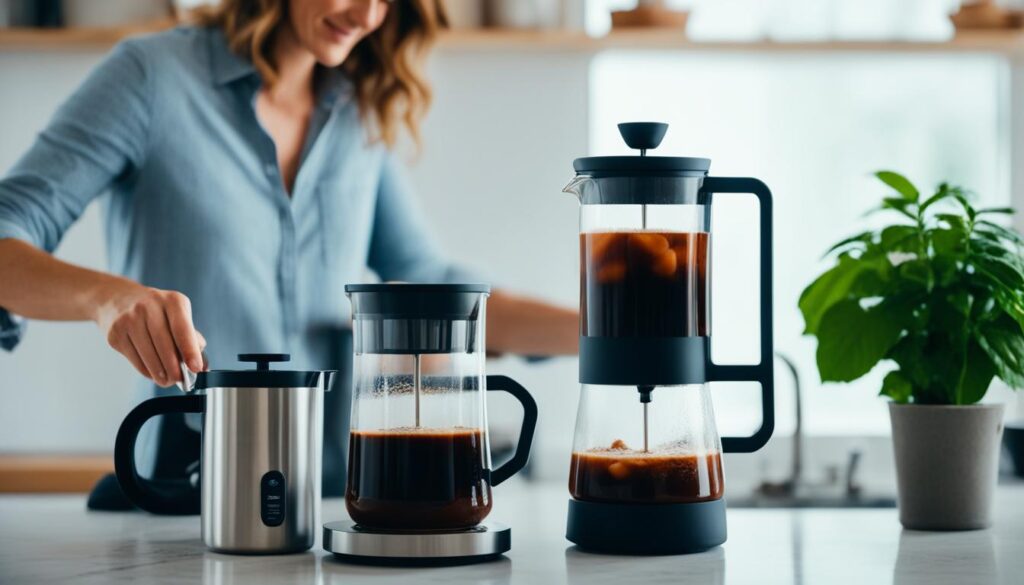
| Brewing Method | Ingredients Ratio | Steeping Time | Flavor Profile |
|---|---|---|---|
| Cold Brew | 1:18 (50g to 32oz) | 12-24 hours | Smooth, less acidic |
| Iced Coffee | Varies (similar to Cold Brew) | Depends on cooling time | Stronger, more bitter |
Learning to brew cold brew and iced coffee at home is rewarding. Both methods not only better the taste but also let you make your drink just right. You can enjoy the gentle cold brew or the brisk iced coffee. Home brewing makes your coffee moment special, right in your kitchen.
Common Misconceptions About Cold Brew and Iced Coffee
Many people don’t know the differences between cold brew and iced coffee. They are also unaware of how these differences affect their health and wallet. Knowing these facts can help you make better coffee choices.
Cooling Methods and Health Effects
Cold brew and iced coffee have different health impacts. Cold brew is made by soaking beans in cold water for over twelve hours. This method makes the coffee less acidic. It’s a good choice for those with a sensitive stomach or acid reflux.
Iced coffee, however, is brewed hot and then cooled down. This often makes it more acidic. Some people might find this type of coffee hard to stomach.
Cost Differences in Cafés
There’s also a misconception about their costs in cafés. Cold brew is usually more expensive. This is because it takes more coffee and time to make. Despite the higher price, cold brew offers stronger flavor and more caffeine.
Iced coffee is cheaper and faster to make. It uses less coffee, which is why it costs less. Knowing these cost differences can help you choose which coffee is worth your money.

Conclusion
Cold brew and iced coffee each have their special traits. Cold brew is smoother and has less acid because it steeps for 12-14 hours. It also has antioxidants. This makes it great for people who find regular iced coffee too harsh.
Iced coffee, on the other hand, is known for its vibrant taste. You can make it fast, in less than 15 minutes. It’s perfect for those who need a quick energy boost. While it doesn’t have as many health benefits as cold brew, it does help increase metabolism.
Choosing between cold brew and iced coffee comes down to what you like and the health benefits you want. Both fit well into the world of coffee, meeting different tastes and health needs. No matter which one you pick, each offers a satisfying caffeine experience for all coffee lovers.
